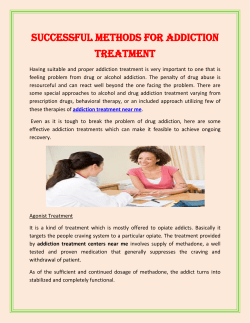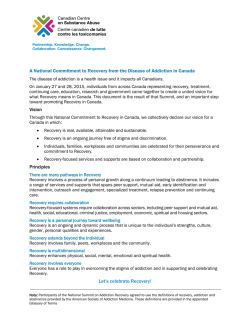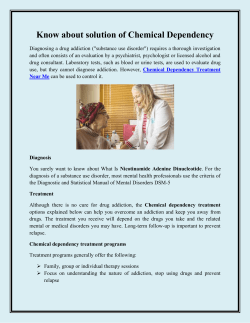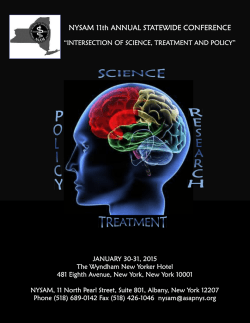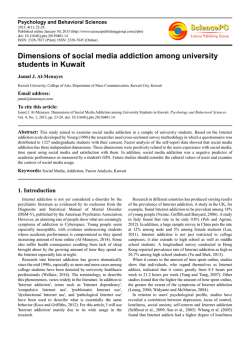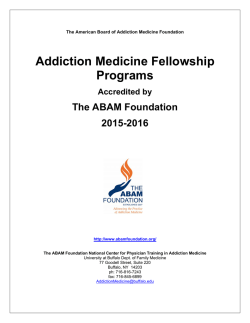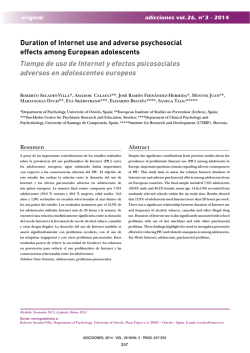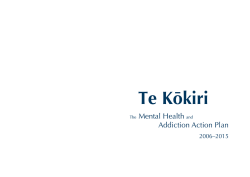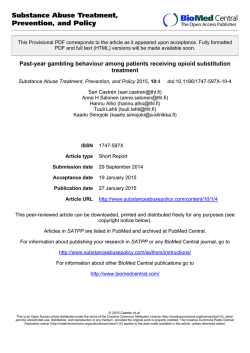
Te Tahuhu - Improving Mental Health 2005-2015
Te Tähuhu Improving Mental Health 2005–2015 The Second New Zealand Mental Health and Addiction Plan 2005 Te Tähuhu Improving Improving Mental Mental Health Health 2005–2015 2005–2015 The Second New Zealand Mental Health and Addiction Plan Te Tähuhu Te Tähuhu is the ridgepole that provides essential support. Citation: Minister of Health. 2005. Te Tähuhu – Improving Mental Health 2005–2015: The Second New Zealand Mental Health and Addiction Plan. Wellington: Ministry of Health. Published in June 2005 by the Ministry of Health, PO Box 5013, Wellington, New Zealand ISBN: 0-478-29606-1 (Book) ISBN: 0-478-29607-X (Internet) HP 4129 This document is available on the Ministry of Health’s website: http://www.moh.govt.nz Foreword Our mental health is important. It enables us to seize new opportunities, overcome challenges and reach our potential. It also helps us to make the most of our families, our friendships, our jobs, our communities and live our lives to the full. However, none of us can afford to take our mental health for granted. One in five New Zealanders experience a mental illness or an addiction, and this takes a huge toll on individuals and their families, on society and on the economy. People with mental illness and addiction can also experience severe discrimination, and this undermines their recovery. We have come a long way since the current Mental Health Strategy was first released in 1994, and this plan mirrors the change in attitudes that has occurred since the time when mental illness was poorly understood and rarely spoken about. It also reflects an increased understanding amongst more and more New Zealanders that mental illness can affect any one of us, and builds on a number of encouraging developments. Specialist services have expanded to meet the growing needs of people, the quality of services has improved and we have a skilled, capable, committed workforce. People who have spent much of their lives in institutional care are now living in communities and are better able to enjoy the same opportunities and privileges as any other New Zealanders. The development of the Primary Health Care Strategy has also provided new opportunities for primary health care services to respond to the mental health needs of their populations. Compared with a decade ago, more people can have a say about the delivery of mental health and addiction services, and the creation of District Health Boards has given local communities a real stake in determining how their needs are met. Non-governmental organisations, Mäori and Pacific mental health providers, service users and families also now play a crucial part in delivering services, and people with a mental illness or addiction are taking lead roles in the sector. While much has been accomplished, much is still to be achieved. The Blueprint is not yet fully implemented and service gaps remain in some areas. The Government remains committed to implementing the Blueprint and this is a priority woven into this Second New Zealand Mental Health and Addiction Plan. When the draft plan was released for comment last year, the overwhelming message I received was that it should be more strategic and overarching. Te Tähuhu – Improving Mental Health 2005–2015 iii I am proud of the strides New Zealand has made to support people with a mental illness and addiction and I am pleased to present this document which: • builds on the current mental health strategies and draws together Government interests in mental health and addiction • broadens the Government’s interest in mental health from people who are severely affected by mental illness to all New Zealanders – while continuing to place an emphasis on ensuring that people with the highest needs can access specialist services • sets out government outcomes for mental health and addiction • clarifies priorities for action to 2015 • builds on past successes, establishes a platform to maintain momentum and provides a mandate for leadership. Hon Annette King Minister of Health iv Te Tähuhu – Improving Mental Health 2005–2015 Contents Foreword ................................................................................................................... iii Introduction................................................................................................................ 1 This Plan .................................................................................................................... 3 Government Outcomes for Mental Health and Addiction........................................... 4 Ten Leading Challenges.............................................................................................. 7 Promotion and Prevention ..................................................................................... 8 Building Mental Health Services ............................................................................ 9 Responsiveness ................................................................................................... 11 Workforce and Culture for Recovery ................................................................... 12 Mäori Mental Health ........................................................................................... 13 Primary Health Care ............................................................................................ 14 Addiction ............................................................................................................ 15 Funding Mechanisms for Recovery ...................................................................... 16 Transparency and Trust ....................................................................................... 17 Working Together ............................................................................................... 18 From Challenges to Action ....................................................................................... 19 Conclusion ............................................................................................................... 20 References ................................................................................................................ 21 Te Tähuhu – Improving Mental Health 2005–2015 v Introduction First steps to a mental health policy New Zealand first developed a co-ordinated mental health policy in 1994, with the Mental Health Strategy, Looking Forward (Ministry of Health 1994). The document made mental health a priority for the Government and emphasised the need for more services for people. It also signaled the Government’s commitment to developing community-based services. Three years later, Moving Forward, the first Mental Health Plan (Ministry of Health 1997), emphasised the need for better services. The first plan was followed in 1998 by the Mental Health Commission’s Blueprint (Mental Health Commission 1998), which detailed the service developments needed to put Moving Forward into action. Looking Forward, Moving Forward and the Blueprint have resulted in a number of significant achievements, including: • a steady growth in access to specialist services and a growth in clinical capacities • continued progress in helping people move from institutional care into the community • a rapid growth in the non-government sector and in the number of Mäori mental health providers. These achievements have been made possible by government commitment to a number of funding packages that have led to substantial increases in funding for the sector – from $465 million (GST excl) in 1997/98 to $863 million (GST excl) in 2004/05. Recent developments Times have changed since Looking Forward, Moving Forward and the Blueprint were written, and in the past decade, a number of important developments have impacted on the way mental health services are delivered. These include: • the establishment of 21 District Health Boards (DHBs), which are responsible for determining the mental health needs of their communities and planning and delivering services • the development of Primary Health Organisations (PHOs), funded through DHBs with the aim of providing primary health care services to their enrolled populations • the integration of mental health into the broader health system and the development of four key health strategies to give the health and disability sector an overall focus: the New Zealand Health Strategy in 2000 (Minister of Health 2000), the New Zealand Disability Strategy (Minister for Disability Issues 2001) and the Primary Health Care Strategy (Minister of Health 2001) in 2001 and He Korowai Oranga: the Mäori Health Strategy in 2002 (Minister of Health and Associate Minister of Health 2002) Te Tähuhu – Improving Mental Health 2005–2015 1 • the continuing growth of a clinical workforce committed to evidence-based practice, and the recognition that service delivery must be both needs and evidence based • the growth of a strong consumer voice and a recognition that services must be built around the needs of the people who use them • the development of a recovery philosophy that underpins services for people and recognises that service users must lead their own recovery, have personal power and a valued place in their whänau and communities • an increasing recognition that family and whänau must be involved in service delivery and treatment • government reforms that have placed an emphasis on improving the performance of State services • recognition that social and economic factors such as employment, housing and poverty all impact on mental health, wellbeing and recovery – and an understanding of how essential it is that all parts of the State sector, and wider community services, work together to provide services. These health sector changes sit alongside other social trends, including: • New Zealand’s growing ethnic diversity. Mäori make up nearly 15 percent of the population, Pacific peoples nearly 7 percent, and Asian peoples 6.4 percent. Ethnic communities include people who identify with ethnic groups originating from across the world as well as people who may also identify as migrants and refugees. Mental health services must be able to respond to the unique needs of all New Zealanders. • ongoing developments in technology, from changes in pharmolocogy to new ways of gathering, managing and sharing information. The development of telepsychiatry for people in remote areas and the increasing use of the Internet for self-management are becoming a reality for many people. • a global workforce. New Zealand’s mental health services have had to work hard to recruit and retain staff. The increasing number of health professionals from overseas has implications for service delivery, local knowledge and cultural understanding. • changing professional roles. Roles for the next generation of mental health workers will evolve to meet the changing environment. New disciplines may emerge, and established jobs may change. • changing attitudes. Sound progress has been made over the last eight years in tackling stigma and discrimination, and general public surveys show significant improvements in attitudes and support for people with mental illness. It is within the dynamic and evolving health environment and against these wider societal trends that the mental health sector faces an important challenge to make a difference for all New Zealanders. 2 Te Tähuhu – Improving Mental Health 2005–2015 This Plan Building on past success This plan draws together the Government’s priorities for mental health and addiction services and builds on previous successes. Unlike previous strategies, this plan sets out the outcomes that the Government expects State services (which comprise all departments and Crown entities), and other agencies to pursue. These outcomes are clear, unambiguous and aimed at letting people know what they can expect from mental health and addiction services. The plan also sets out: • priorities that must be tackled collectively if the outcomes are to be achieved • how this plan will be implemented through the development of a detailed action plan. The approach This new approach reflects a wider move across the State services to ensure that Government and New Zealanders feel able to trust the services they fund and use. This plan is for all New Zealanders and will: • provide a uniform set of directions to govern mental health and addiction services, no matter which agency provides them or how they are funded • give mental health workers an overall sense of how their work fits into the total picture of mental health and mental health services • support the Government’s ongoing investment in funding and services needed to advance the outcomes and priorities in this statement • support the Government’s commitment to developing a more innovative and accountable funding environment. Te Tähuhu – Improving Mental Health 2005–2015 3 Government Outcomes for Mental Health and Addiction The Government expects State agencies to demonstrate that mental health and addiction services are trustworthy, accountable and produce results. This section sets out the mental health and addiction outcomes or results that the Government expects State services and other government-funded agencies to pursue. The outcomes establish the overall direction for the Government’s ongoing investment in mental health and addiction services. They also give people who use the services a clear idea of what they should be able to expect. Outcome statements General and service-oriented outcome statements have been developed for three specific groups: • all New Zealanders in their communities • people with experience of mental illness and addiction • family/whänau and friends who support and are affected by people with experience of mental illness and addiction. The general outcome statements describe what people should be able to do. For example, all New Zealanders should be able to “make informed decisions that promote their mental health and wellbeing”. People with experience of mental illness and addiction should also have “the same opportunities as everyone else, to fully participate in society and in the everyday life of their communities and whänau”. The service outcomes set out the expectations people should have of mental health and addiction services. For example, people with experience of mental illness and addiction should “experience trustworthy agencies that work across boundaries and enable service users to lead their own recovery”. 4 Te Tähuhu – Improving Mental Health 2005–2015 The Government’s outcomes for mental health and addiction are described below. All New Zealanders in their communities People make informed decisions to promote their mental health and wellbeing value diversity and support and enable people with experience of mental illness and addiction to fully participate in society and in the everyday life of their communities and whänau Service see a trusted and high-performing mental health and addiction sector, and have confidence that if they need them, they can access high-quality mental health and addiction services People with experience of mental illness and addiction Person have the same opportunities as everyone else to fully participate in society and in the everyday life of their communities and whänau Service experience trustworthy agencies that work across boundaries and enable service users to lead their own recovery experience recovery-focused mental health services that provide choice, promote independence, and are effective, efficient, responsive and timely Whänau and friends who support and who are affected by people with experience of mental illness and addiction Person maintain their own wellbeing and participate in society and in the everyday life of their communities and whänau Service experience agencies that operate in a way which enables them to support their family members’ recovery and maintain their own wellbeing Te Tähuhu – Improving Mental Health 2005–2015 5 Ten Leading Challenges The mental health and addiction sector is committed to continuously improving the quality of its services, and while the sector has made significant achievements, it continues to face challenges that could impact on its ability to capitalise on past successes. These challenges must now be met if the sector is to continue to grow and thrive. An agenda for action This section sets out the leading challenges or action priorities for the mental health and addiction sector for the next 10 years. While the Government has set a 10-year timeframe, it expects priorities to change as challenges are met and new challenges arise. It may also redefine challenges that have been partially addressed – leaving some aspects still to be tackled. The Ministry of Health’s website, www.moh.govt.nz, will contain an up-to-date list of the current challenges and the progress being made on meeting them. The challenges The following challenges reflect the complex nature of the mental health and addiction sector. Some of the challenges are pitched at a high level, while others are at an operational level. However, the sector needs to make progress on all the challenges to ensure it continues to deliver meaningful results for people. The challenges are not expressed in order of importance. Each has a title, a ‘headline statement’ and ‘with emphasis’ bullet points, which indicate where the Government expects focus to be directed over the next three years. Te Tähuhu – Improving Mental Health 2005–2015 7 Promotion and Prevention Promote mental health and wellbeing, and prevent mental illness and addiction with immediate emphasis on: • increasing people’s awareness of how to maintain mental health and wellbeing • how employers and others in frequent contact with people with mental illness and addiction can be more inclusive and supportive • ensuring that people who are discriminated against can receive effective support, protection and redress when they are discriminated against • implementing the Government’s strategy to reduce suicide and suicide attempts, and the negative impacts of depression • improving understanding of the nature of addictive behaviours and the use of early interventions to prevent or limit harm. This challenge confirms that mental health and wellbeing is more than the absence of mental illness or addiction; it is vital to individuals, families and societies. One in five New Zealanders experience a mental illness or addiction. Many people with mental illness and addiction are marginalised and stigmatised as a result, and misunderstanding about mental illness and addiction in the general community remains. Important next steps to address discrimination involve supporting employers and others to be more inclusive and supportive, to identify and eliminate discriminatory practice and to enable service users to gain support, protection and redress if they are discriminated against. Mental health and addiction problems, such as depression, anxiety disorders, and substance misuse, can reduce an individual’s sense of belonging and participation in society. Stigma and discrimination can be both a consequence and a cause of social exclusion, and a major barrier to successful participation in society for excluded groups and individuals. Depression is one of the most common mental health problems, yet its symptoms are not well understood, and people do not always seek help. This can delay treatment and affect recovery. There is also a strong link between depression, anxiety disorders and substance misuse. Suicide and attempted suicide are serious health and social issues. In the past few years, New Zealand has focused on preventing youth suicide, but it is now time to work on preventing suicide across all age groups. Looking at risk factors and promoting protective factors that strengthen communities – such as enhanced cultural awareness, sensitivity and competence, affirmation, and promoting access to the resources of mainstream society to encourage full participation in society – are important for the mental health of disadvantaged groups. 8 Te Tähuhu – Improving Mental Health 2005–2015 Building Mental Health Services Build and broaden the range and choice of services and supports, which are funded for people who are severely affected by mental illness. With immediate emphasis on: • increasing services that are funded for children and young people and for older people • broadening the range of services and supports that are funded for adults. This challenge emphasises the importance placed on building and broadening the range and type of services available for people severely affected by mental illness whilst maintaining a focus on the continuing development of existing services. This challenge also confirms that the Government remains committed to providing services for people who are severely affected by mental illness, especially those who have enduring severe illness. Service users need easy and well-recognised access to services that are: • focused on wellness and recovery • high quality • built on an evidence base of what works best • provided in the least restrictive environment. Services that work well for people understand the balance between biological, psychological and social factors, as well as cultural and spiritual contributions to mental health. These services also recognise the broader impacts of employment, housing, educational and income needs and the effect of these on mental health and wellbeing and on recovery. Quality services recognise the unique needs of men and women and children and young people, and organise their services to work with service users in meeting these needs. Children and young people The number of specialist services for children and young people has increased, but gaps in access still remain, and lag well behind those of adult services. Quality services for children and young people acknowledge the wider environment of the child or young person and recognise the need for State services to work together to effectively address those needs. Evidence tells us that early interventions in a number of mental health conditions for children and young people can result in better outcomes. Services for at-risk mothers and infants provide opportunities for healthy development and lessen the possibility of future problems. Te Tähuhu – Improving Mental Health 2005–2015 9 Older people Access to services for older people also remains well below expectations. An ageing population means that addressing the mental health needs of this group will be increasingly important in the years to come. Mental illness in older people is often complicated by conditions more commonly associated with ageing, in particular physical and cognitive conditions. Where such complications occur, specialist expertise is required. Quality services will recognise and respond to these multiple and complex needs through effective multidisciplinary co-operation. The primary health care sector is often the first point of contact when people experience a mental illness. The capacity of providers to recognise and determine people’s needs is important in ensuring people gain access to appropriate services. Adults Considerable progress has been made in developing services for adults, but gaps remain. People severely affected by mental illness are best served by access to a broader range of services that provide safe and effective resources and solutions. Such services include quality crisis services; psychological therapies; peer support services; home and family support services – including practical assistance; service user led services and culturally specific services. There are people with specific mental health needs who require services that have focused expertise to meet and address their needs. Such people include those with eating disorders, personality disorders, people who have suffered trauma, and people with disabilities. The special needs of people with mental health needs and addiction who are currently in the justice system or who are Special Patients are the focus of forensic mental health services. The partnership between mental health services, disability services and the justice system will continue and strengthen to ensure the needs of people are met in ways that enhance their physical, psychological and social safety and stability. 10 Te Tähuhu – Improving Mental Health 2005–2015 Responsiveness Build responsive services for people who are severely affected by mental illness and/or addiction – with immediate emphasis on improving the responsiveness of services for: • Pacific peoples • Asian peoples and other ethnic communities • Refugee and migrant communities • people with specific disabilities • family and whänau • Mäori. This challenge reinforces the importance of services meeting the unique needs of specific population groups. Responsive services focus on recovery, recognise New Zealand’s growing ethnic diversity and consider people’s cultural needs as well as their clinical needs. Issues to be taken into account include spirituality, family and different understandings of mental health and wellbeing and recovery. Recovery-oriented services understand that people with mental illness or addiction have families, whänau and communities. They recognise the impact that mental illness and addiction can have on families and whänau, and include them in treatment. Responsiveness to Mäori is built on the recognition of whänau ora, or healthy families, which builds on the strengths of whänau and encourages whänau development. Pacific peoples generally enter mental health services at a later stage of illness with more severe symptoms. Responsive services understand and implement Pacific models of care based on Pacific understandings of health and wellbeing. Ethnic communities are a growing part of New Zealand’s population. Language barriers, social isolation, intergenerational and disrupted family and social relationships are among the problems experienced by different ethnic groups, including migrants, refugees and their descendants. Ethnic youth, women and older people are particularly at risk, as are refugees and migrants from refugee-like circumstances who have experienced severe trauma. People with intellectual disability and mental illness and people who have experienced head injuries or who have physical or sensory disabilities will need specialised expertise to respond to those needs. Women face particular cultural and gender issues when they access forensic and acute services. Parents with mental illness and/or addiction who have dependent children have been identified as a group in need of specific support and assistance. Family focused care practices are needed to support parents and to meet the needs of their children. Te Tähuhu – Improving Mental Health 2005–2015 11 Workforce and Culture for Recovery Build a mental health and addiction workforce – and foster a culture amongst providers – that supports recovery, is person centered, is culturally capable and delivers an ongoing commitment to assure and improve the quality of services for people. With immediate emphasis on: • building a workforce to deliver services for children and young people, Mäori, Pacific peoples, Asian peoples, and people with addiction • supporting the development of a service user workforce • creating an environment that fosters leaders across the sector • developing a culture amongst providers of involving whänau/families and significant others in treatment and recovery • fostering a culture among providers that promotes service user participation and leadership • developing a culture of continuous quality improvement in which information and knowledge is used to enhance recovery and service development. This challenge emphasises the importance of a knowledgeable, skilled, competent, recovery-focused workforce that is culturally capable and able to meet the needs of diverse ethnic communities. It also recognises that while the mental health and addiction workforce has rapidly expanded over the past 10 years, workforce challenges remain. Opportunities now exist for new disciplines and roles to emerge and for established, professional boundaries to continue to evolve – the changing role of nurse practitioners and the development of a service user workforce are good examples of this change. However, the future, emerging workforce will need to ensure that it can deliver the right ’mix’ of services for people – with perhaps the most significant factor shaping the need for new skills and areas of specialised knowledge being the change in the make-up of our demographics, with an increase in the number of Mäori and Pacific youth and Asian people making up our population. Without good people, the sector cannot be effective, and we need to continue to develop a workforce that has the skills and a commitment that enables and encourages services users to take leadership and governance roles. ‘Working together’ in complementary partnerships is a fundamental principle in enabling people to lead their own recovery. We also need to strengthen working environments so that people – regardless of the level they work – can exercise leadership and drive service-level improvements. The Government is committed to this important challenge and acknowledges that developing a responsive workforce and culture for recovery will be integral to the outcomes in this plan. 12 Te Tähuhu – Improving Mental Health 2005–2015 - Mental Health M aori Continue to broaden the range, quality and choice of mental health and addiction services for Mäori – with immediate emphasis on: • enabling Mäori to present earlier to mental health and addiction services • promoting choice by supporting the implementation of kaupapa Mäori models of practice • increasing Mäori participation in the planning and delivery of mental health and addiction services for Mäori. This challenge places a priority on improving Mäori mental health. Over the past 12 years, there has been significant growth and development of a diverse range of mental health and addiction services for Mäori. This has been supported by the development of a capable workforce and an evolving research and evaluation base. These achievements establish a solid foundation. Despite these service improvements, Mäori still tend to access mental health services at a later stage of illness and with more severe symptoms. Therefore, improving our knowledge of existing and new data about Mäori mental health and addiction-related needs continues to be critical. There is a strong link between health and culture, and the wellness of tangata whaiora (people seeking wellness) both depends on and is affected by the wellness of whänau. Services will improve when Mäori take an active role in planning and delivering services, and when models of practice incorporate a better understanding of the importance of whänau, and the interface between culture and clinical practices. The Government remains committed to these challenges and growing Mäori services in the future to improve the mental health of tangata whaiora and whänau ora. Te Tähuhu – Improving Mental Health 2005–2015 13 Primary Health Care Build and strengthen the capability of the primary health care sector to promote mental health and wellbeing and to respond to the needs of people with mental illness and addiction. With immediate emphasis on: • building the capability of primary health care practitioners to assess the mental health and addiction needs of people and to meet these when they can best be met within primary health care settings • building linkages between Primary Health Organisations (PHOs) and other providers of mental health and addiction services to ensure integration occurs to meet the needs of all people with mental illness and addiction • strengthening the role of PHOs in communities to promote mental health and wellbeing and prevent mental ill health. This challenge acknowledges the importance of the primary health care sector in meeting communities’ mental health needs. The change in the structure and funding of the primary health care sector brought about by the implementation of the Primary Health Care Strategy provides an opportunity to improve responsiveness to mental health needs as an integral part of PHOs. Research from New Zealand and internationally suggests about a third of people who consult general practitioners (GPs) have a mental health problem or illness at the time of the consultation, or have experienced one in the past year. A New Zealand study found (MaGPIe Research Group 2003) that about one-third of patients had experienced a diagnosable mental illness in the past 12 months, and half had experienced one within the past month. GPs identified mental health problems in about half of the people in the study, even though many were seeing their doctor for a different complaint. For many people, the primary health care sector will be their first point of contact with the health system. Picking up problems at the earliest possible time and providing the right treatment in the right setting can prevent distress and suffering, prevent some problems becoming more severe and enhance recovery. There is increasing evidence that people with mental illness have significant physical health problems that are often neglected. Greater connectedness between primary health care providers and mental health services will mean a more holistic approach can be taken to people’s needs that will result in better health outcomes overall. Also, people with physical illnesses often suffer depression, anxiety or have a substance abuse problem. Improved integration of services will lead to earlier recognition of these disorders and again will lead to better outcomes. PHOs, as local providers funded by DHBs, provide a range of primary health care services to their enrolled populations. They, like other primary health care providers, have an opportunity to emphasise the importance of good mental health and wellbeing in every aspect of health care. 14 Te Tähuhu – Improving Mental Health 2005–2015 Addiction Improve the availability of and access to quality addiction services and strengthen the alignment between addiction services and services for people with mental illness – with immediate emphasis on: • broadening the range of services that are funded for substance use problems • maintaining and developing responsive and effective problem gambling services • building the expertise of addiction and mental health providers to conduct complementary assessments and treatment planning. This challenge recognises that addiction imposes a high cost on individuals, whänau and the wider community. Substance abuse and problem gambling are increasing problems for many young people, and there are also significant issues for people who have contact with the criminal justice system. A broad range of services are required to meet the addiction needs of all people – young people, adults, older adults, and those in the criminal justice system. A growing number of people have an addiction (either from alcohol and/or other drugs or from gambling) and a mental illness. It is vital that “any door is the right door” with close alignment between mental health and addiction services and between problem gambling services and alcohol and other drug services, and that individuals and families have clear recovery pathways. Evidence suggests there is also an increase in the number of people with gambling problems. More services will be needed to address the specific needs of this group. For all addictions, models of service will range from brief early interventions to withdrawal services and longer treatment and support programmes, which address the physical and psychological needs of individuals and their families, as well as wider social and financial issues. Innovation and flexibility is required to meet the constant changes in the wider addiction environment, such as new drugs and Internet gambling. Te Tähuhu – Improving Mental Health 2005–2015 15 Funding Mechanisms for Recovery Develop and implement funding mechanisms for mental health and addiction that support recovery, advance best practice and enable collaboration. With immediate emphasis on establishing funding models, contracting processes and service frameworks that: • foster learning and evaluation • promote the seamless delivery of services between providers and across boundaries • remove incentives that can keep some service users tied to certain services and enable providers to adapt the services they provide to better meet the needs of service users • enable the development of provider capability. This challenge recognises that funding mechanisms are instrumental in shaping the services that are purchased by State agencies and delivered by providers. This plan broadens the Government’s interest in mental health and addiction services for all New Zealanders. It also signals an ongoing commitment to services for people who are severely affected by mental illness and addiction. Innovative and pioneering funding mechanisms will be needed, within the life of this plan, to balance demands and shift the basis upon which services are funded to better enable seamless delivery of services for people. 16 Te Tähuhu – Improving Mental Health 2005–2015 Transparency and Trust Strengthen trust – with immediate emphasis on: • increasing the availability of information and information systems to underpin service development, which support decision making and improve services for people • creating an environment that enables DHBs to demonstrate that their investments in mental health and/or addiction deliver value for money, are results-focused, and have regard to service impacts on people who are severely affected by mental illness and addiction • creating an environment where mental health workers and service users can readily use information to support and enhance recovery. This challenge recognises the importance of the public seeing a trusted and high-performing mental health and addiction sector. It clarifies that State agencies that fund mental health and addiction are accountable to government for the investments they make. It also recognises that New Zealanders are entitled to transparency and value for money for the services they receive. Real strides have been made in data collection and information systems over the past decade, and these improvements continue to support observations about the performance of the sector. However, more needs to be done to improve the availability of information and the systems that support this information so that State agencies can: • continue to improve the delivery of mental health and addiction services for people • demonstrate that their investments are focused and deliver value for money. This will not only require a shift in the way information is collected by State agencies that fund services, it will also require a shift in the way information is reported by providers and a shift in the way information is used by clinicians and service users. Building a more accurate picture of the services provided by all NGOs will be important, as will providing services users with easy access to their information. The legislative environment within which services are delivered is also important and opportunities should be taken to review and update the Mental Health Act 1992. The New Zealand Survey of Mental Health and Wellbeing, currently being undertaken, will help us understand mental health in the adult population and the ways in which people access services. This study will support this and other challenges. Te Tähuhu – Improving Mental Health 2005–2015 17 Working Together Strengthen cross-agency working together – with immediate emphasis on strengthening: • regional and national collaboration between DHBs to promote the optimal use of resources, minimise clinical risk and maximise in-demand work force capabilities • the alignment between the delivery of health services and the delivery of other government-funded social services. This challenge acknowledges that effective partnerships across health services and other government-funded social services are critical in supporting people with a mental illness or an addiction. Working together will mean that effective partnerships will need to be built: • between mental health workers and addiction treatment workers and service users • between mental health and addiction services and other health services • between DHB providers, non-governmental organisations and PHOs • across health services and other social services. To provide continuity of care, it is essential that different parts of the mental health system work well together. By working together, DHBs will be able to share innovative ideas, solve problems and improve access to services. A wide range of social and economic factors impact on people who have a mental illness or an addiction. Housing, employment and education are all important in ensuring people with mental illness are included in society and supported in their recovery. Many services in the community are ideally placed to identify people showing early signs of mental health problems. Relationships must be developed between primary health care, housing, employment, education and welfare services. Strong partnerships and networks will give more co-ordinated support to people affected by mental illness or addiction. 18 Te Tähuhu – Improving Mental Health 2005–2015 From Challenges to Action Defining the actions necessary to tackle these challenges will be an exacting task. The challenges are complex, and while the primary responsibility for defining and driving a programme of action must rest with the State services, the programme itself will be broader than could be accomplished by State agencies working alone. Stewardship expectations The Government now expects this plan to be implemented through a detailed action plan. In order to maintain the momentum generated through this strategy and sustain the leadership needed to complete a programme of change, the Government has four explicit expectations in respect to implementing this Plan and developing an action plan. The Ministry of Health and DHBs will be held accountable for their stewardship of these expectations. The Government’s expectations are as follows. A joint action plan for Cabinet by March 2006 • The Ministry of Health and DHBs will work together to jointly develop – for Cabinet by March 2006 – an agreed action plan to 2015 to tackle the leading challenges. Stakeholder involvement • The Ministry and DHBs will work with stakeholder representatives in developing the action plan. Measures and logic • The plan will include clear rationale for and impact measures of the actions proposed by the Ministry of Health and DHBs. Reporting • The public will be kept informed of progress – and the Ministry of Health will report to the Minister of Health for consideration by Cabinet at least once a year on progress and delivery of the action plan. Te Tähuhu – Improving Mental Health 2005–2015 19 Conclusion In the past 10 years, all those involved in mental health have built a strong foundation of services for New Zealanders. This strategic plan signifies a new era for mental health and addiction in New Zealand. A new sense of direction is essential if we are to continue to build on the strengths of past successes and achievements. People who use services need to know what they can expect, service providers need to know what standards they must meet and mental health and addiction workers need to know how their work fits into the big picture. This statement gives that clear sense of direction. It builds on the current mental health strategies and draws together Government’s interests in mental health and addiction. It also sets out the Government’s priorities for the next decade, and answers the call from the mental health and addiction sector for a more strategic plan. The environment is rapidly changing, and innovation will be needed if we are to continue to provide services that make real improvements in people’s lives. Government’s expectations have also changed, and in the future services will move towards being funded on what they are able to deliver. New Zealanders need to know that government investments in mental health make a difference and that services are effective, efficient and accountable. Many challenges lie ahead. These include broadening the range of services for people who are severely affected by mental illness; improving our understanding of Mäori models of mental health and wellbeing; meeting the needs of an ethnically diverse society, and ensuring primary health care workers play their part in recognising early signs of mental illness and addiction. Boundaries must be broken down if we are to reach our goals, and many of the factors that influence mental health and wellbeing lie outside the health sector – which is why Government expects more co-operation between State services. Pioneering funding arrangements, greater transparency in the way services operate, choice and an emphasis on results is also needed. Mental health and wellbeing is complex, and there are many different views about the best way forward, and while change is inevitable, we now have a series of benchmarks that we can all work towards to make a difference in the lives of all New Zealanders. 20 Te Tähuhu – Improving Mental Health 2005–2015 References MaGPIe Research Group. 2003. The nature and prevalence of psychological problems in New Zealand primary healthcare: a report on Mental Health and General Practice Investigation (MaGPIe). New Zealand Medical Journal 116 (1171). Mental Health Commission. 1998. Blueprint for Mental Health Services in New Zealand: How things need to be. Wellington: Mental Health Commission. Ministry of Health. 1994. Looking Forward: Strategic directions for the mental health services. Wellington: Ministry of Health. Ministry of Health. 1997. Moving Forward: The National Mental Health Plan for More and Better Services. Wellington: Ministry of Health. Minister of Health. 2000. The New Zealand Health Strategy. Wellington: Ministry of Health. Minister for Disability Issues. 2001. The New Zealand Disability Strategy: Making a world of difference: Whakanui oranga. Wellington: Ministry of Health. Minister of Health. 2001. The Primary Health Care Strategy. Wellington: Ministry of Health Minister of Health and Associate Minister of Health. 2002. He Korowai Oranga: The Mäori Health Strategy. Wellington: Ministry of Health. Te Tähuhu – Improving Mental Health 2005–2015 21 Te Tähuhu
© Copyright 2025
